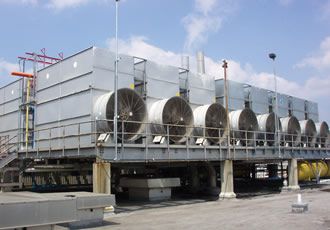Tackling Damaging Biofilms in Water Cooling Systems
Published on by Water Network Research, Official research team of The Water Network in Technology
NCH Europe's Water Treatment Innovation Platform is launching a patented product for biofilm treatment.

This new product, bioeXile is a breakthrough that has been designed to remove biofilms from water cooling systems and save plant managers money.
Biofilms are made up of bacteria that have adhered to a surface and the ‘slime’ they produce to form an insulating, protective layer around them.
They spread as the bacteria multiply and insulate the pipe, making a water cooling system less effective and much more expensive to run.
This product launch will help to reduce manufacturing costs for many industries that depend on cooling systems, from plastic moulding to food processing plants.
“Biofilm layers are difficult to detect, since they can be just a few microns thick,” explained Dr Simona Vasilescu, of the Water Treatment Innovation Platform at NCH Europe. “But businesses should not underestimate how much they can impact on the efficiency of a water cooling system.
A 0.1mm layer of biofilm can reduce efficiency so much that the associated electricity costs of keeping everything running drastically increase, four times the amount than the additional costs resulting from a system with the same thickness of calcium carbonate scale.
“Biofilms are very difficult to remove due to the complex chemically resistant mechanism that holds them together. Our bioeXile product breaks this down, exposing the underlying bacteria to be targeted with biocide treatment.”

As well as severely affecting the heat transfer efficiency, biofilms are also associated with the spread of Legionella bacteria.
Biofilms house and protect Legionella bacteria from biocides, allowing them to proliferate in safety. BioeXile breaks down the protective biofilm and exposes the Legionella bacteria that can be then controlled with biocides.
There are serious consequences of leaving Legionella unchecked. Addressing the problem of biofilms will therefore give plant managers peace of mind in the fight against Legionella.
Biofilms are also a leading cause of microbiological corrosion. This type of corrosion is 10 to 100 times more aggressive than standard corrosion, partly due to the acid secretion within the biofilms. If left untreated, this can have costly consequences to ‘mission critical’ equipment in cooling systems leading to expensive repair works and down time.
Read more: Engineer Live
Media
Taxonomy
- Public Health
- Bacteria
- Treatment
- Technology
- Filtration
- Water Utility
- Utility Management
- Bacteria Control
- water treatment
- Biofilm Monitoring Systems
- Biofilm Sensors
2 Comments
-
How exactly does this product do this?
How my company is handling it in Australia is a multi-barrier approach.
1. Treatment of open loop water (e.g. cooling tower water or potable water supply) to remove organic particles, iron, and manganese which can feed the bacteria colonies and provide a scale substrate for growth.
2. Mechanical disinfection through a static mixer to break apart cell walls, generating ultrafine bubbles and free radicals in the process. Thus, making the microorganism more susceptible to disinfection by residual chlorine or free radicals generated by the cavitation reactions.
3. Filtration of micro-organisms greater than 0.45 micron such as Legionella using Optimised Velocity Filter with Activated Filter Media.
4. Routine monitoring.
We have found this to be the most effective way of managing biofilm formation in hospital water distribution systems.
I do not think there is any one product that will completely eliminate biofilm. Even if this product was to eliminate biofilm for a period, it will come back as long as there is sufficient spores, temperature, and food source to grow. That is why the Australian guidelines and ASHRAE 188 standards call for a multi-barrier approach.
-
You have found your error without even knowing it. The key word is "reduces". 1. Biofilms do not begin to grow unless you are using chlorine compounds. 2.The resistant bacteria as you say becomes vey difficult to clean. 3. This is described as a chlorinated hydrogen. 4. No bacteria on the market or in the universe can eliminate the film you are referring to. 5. It has a DNA code as does all Fungal groups. ***** "they do not have the genetic code for reducing organic compounds into their elemental/nutrient form. 6. (if one side of the sandpaper does not work, turn it over and try the other side). If every DNA microbe in the universe does not work, try the only other type. RNA microbial life forms called Archaea have been proven since the 1950's that they do exactly what their genetic code allows them to do. Compounds into elements. 60 years of research, parameters, properties, and applicable industries have been established. Protocols for each industry is the only research left to do. This does eliminate chlorine use, Pipes last many time their normal. Home use will eliminate the need for infrastructure. Rapidly clean the environment when no waste from humans is being dumped into rivers or land dump sites.